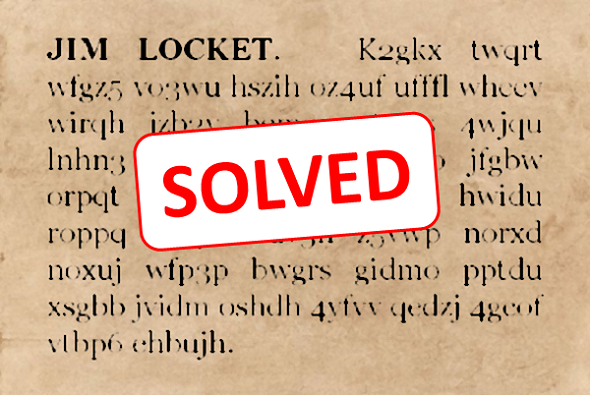Earlier this week, I blogged about an encrypted newspaper ad from 1897. Seth Kintigh from Massachusetts has solved it.
Last Monday, I introduced another encrypted newspaper ad from the book The Agony Column Codes & Ciphers by Jean Palmer (i.e., Tony Gaffney). It was originally published in the London-based Daily Telegraph on Monday, January 4th, 1897. It is reproduced in the following:
JIM LOCKET. – K2gkx twqrt wfgz5 vo3wu hszih oz4uf ufffl wheev wirqh jzb2v bem3u rtwps 4wjqu lnhn3 fwn3b wtr5w 2usdo jfgbw orpqt duxsg bbpug djo4q hwidu roppq edzp6 vuv3h z5vwp norxd noxuj wfp3p bwgrs gidmo pptdu xsgbb jvidm oshdh 4yfvv qedzj 4gcof vtbp6 ehbujh.
This ciphertext mainly consists of five-character blocks, which becomes more apparent if we format the text in a different way:
JIM LOCKET. – K2gkx twqrt wfgz5 vo3wu hszih oz4uf ufffl wheev wirqh jzb2v bem3u rtwps 4wjqu lnhn3 fwn3b wtr5w 2usdo jfgbw orpqt duxsg bbpug djo4q hwidu roppq edzp6 vuv3h z5vwp norxd noxuj wfp3p bwgrs gidmo pptdu xsgbb jvidm oshdh 4yfvv qedzj 4gcof vtbp6 ehbujh.
Analysis
Here are the letter frequencies (counted with CrypTool 2; the two cleartext words are excluded):

Source: CrypTool 2
The alphabet used consists of 30 letters. The frequency distribution is too flat for a simple substitution (MASC). So, I suspected that a homophonic cipher might have been used.
Lance Estes published an interesting comment: “If you had a numeric key running over the top of your plaintext, shifting forward in the A-Z,1-9 alphabet by that value to get cipher, you might get a frequency count that resembles this one and that has no “A” observed in cipher. As an example, if the key began 2623323, and you applied that to the first 7 letters of cipher, you get “ivehurt” (I’ve hurt). If the key repeats we would be in business, but if it doesn’t, well, back to the drawing board.”
The solution
On Tuesday, Seth Kintigh published the solution in the comment section of my blog. He had found out that the creator of the message had used a Vigenère cipher based on a two-letter keyword. Later, he realized that the numbers stood for letters (2=A 3=E 4=I 5=O 6=U). This means that the cipher we are dealing with is a combined MASC and Vigenére system.
In order to decrypt, every letter at an odd position in the message is shifted back by three and every letter at an even position is shifted back by one unit in the alphabet (this is equivalent with a Vigenère cipher based on the keyword DB; we leave the numbers unchanged):
K2gkx twqrt wfgz5 voewu hszih ... 3-313 13131 3131- 13031 31313 ... H2dju stpos tedy5 ulett erwhe ...
Next, the numbers are substituted (2=A 3=E 4=I 5=O 6=U):
Hadju stpos tedyo ulett erwhe ...
Here’s the plaintext:
Had just posted you letter when wire received but hope i waas able to stop it in time meet me at soot arranged at noon saturday or failing that on monday must see you to know aml(?) write me mat fordhall om saturday i shall receive sunday god bless you dearie
How Seth found the solution
After I had read Seth’s comment providing the solution, I sent him a mail, asking for more information. Thankfully, he sent me an immediate response. Here is what he wrote:
I’m Seth Kintigh, I’m from Somerville, MA. I work for Dell in product and application security. My grandmother introduced me to cryptograms as a child and crypto has been an interest of mine ever since. My biggest crypto claims to fame are that I was in 3rd place on Mystery Twister C3 for a while and I was the first person to crack a level X cipher.
I’m at Black Hat right now and don’t have many photos on me, but I’m attaching one from an online profile…

Source: Seth Kintigh (used with permission)
I started by assuming it was a homophonic cipher but zkdecrypto did not find a solution nor even significant patterns, so that seemed a dead end.
Cryptocrack suggested few ciphers, some more plausible than others. The 5th suggestion was Vigenére. With Vigenére it found a key “DBDBDBDBD” and some small pieces of reasonable-looking text. I assumed that meant the key was “DB” and the cipher was going in and out of phase with the key due to the numbers and missing/extra characters and an odd-length key.
I used the Caesar cipher tool at Rumkin.com to make streams shifted by 23 and 25 then manually alternated between the streams writing out what looked reasonable. The numbers 2-3-4-5-6 appear to correspond to a-e-i-o-u with the exception of an extraneous 2 and a 4 that should be a 5/o in “God.’ Realizing that pattern changed my solution slightly:
“Had just posted you letter when wire received but hope i waas able to stop it in time meet me at soot arranged at noon saturday or failing that on monday must see you to know aml write me mat fordhall om saturday i shall receive sunday god bless you dearie”
The numbers made it trickier as they will be ignored and thus confuse all the Vigenére tools that I know of. The extra number will throw the cipher out of phase and can add to the confusion.
Congratulations and thank you very much, Seth! This is another outstanding codebreaking success I have the honor to report about on my blog.
Follow @KlausSchmeh
Further reading: The Richard Feynman cryptograms
Linkedin: https://www.linkedin.com/groups/13501820
Facebook: https://www.facebook.com/groups/763282653806483/



Letzte Kommentare